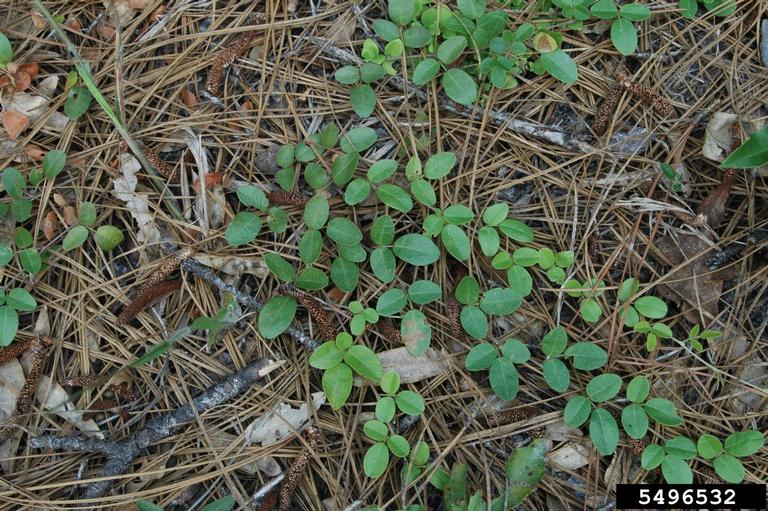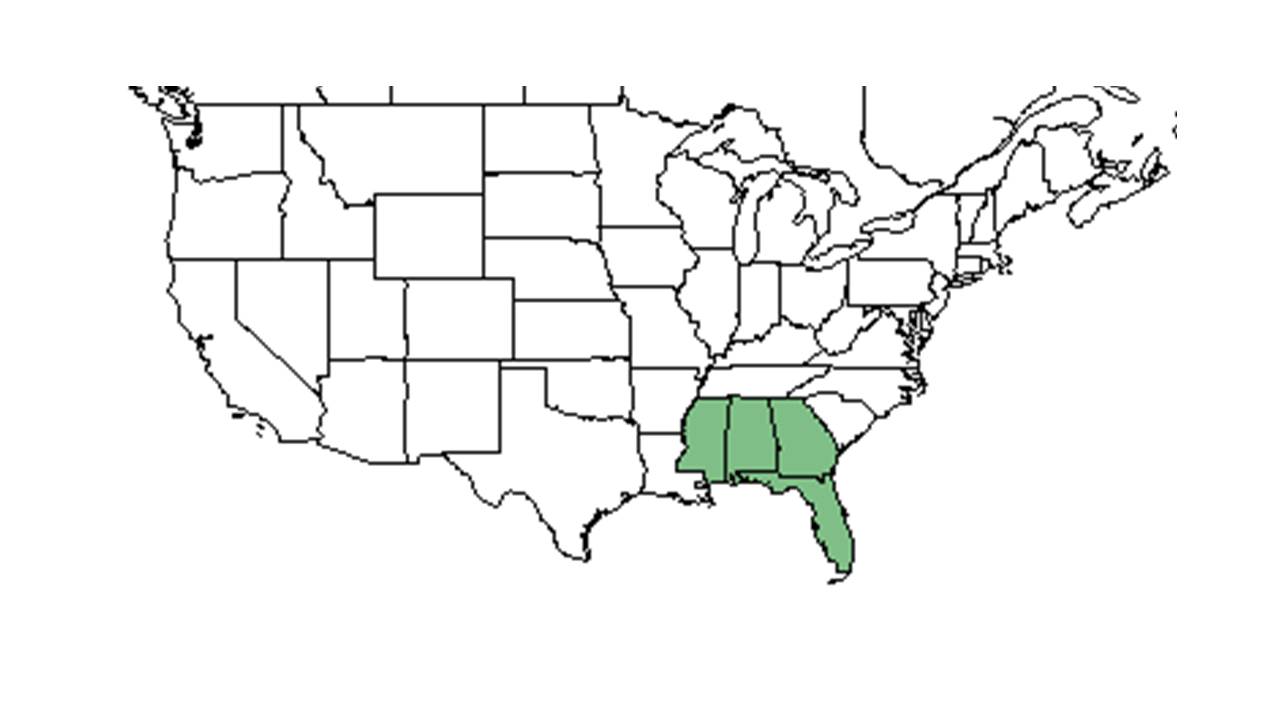Galactia mollis
| Galactia mollis | |
|---|---|

| |
| Photo by Karan A. Rawlins, University of Georgia, Bugwood.org | |
| Scientific classification | |
| Kingdom: | Plantae |
| Division: | Magnoliophyta - Flowering plants |
| Class: | Magnoliopsida – Dicotyledons |
| Order: | Fabales |
| Family: | Fabaceae ⁄ Leguminosae |
| Genus: | Galactia |
| Species: | G. mollis |
| Binomial name | |
| Galactia mollis Michx. | |

| |
| Natural range of Galactia mollis from USDA NRCS Plants Database. | |
Common name: soft milkpea
Contents
Taxonomic notes
Synonyms: none[1]
Varieties: none[1]
Description
Generally, the genus Galactia are "trailing or twining, climbing, perennial, herbaceous or woody vines or erect, perennial herbs or rarely shrubs. Leaves 1-pinnate, usually 3-foliolate (or rarely 1-,5-7-,9-folilolate); leaflets entire, petiolulate, stipellate. Racemes axillary, pedunculate with few to numerous, papilionaceous flowers borne solitary or 2-several at a node, ech subtended by a bract and fusion of the 2 uppermost, with the laterals usually shorter than the uppermost and lowermost; petals usually red, purple, pink or white; stamens diadelphous or elsewhere occasionally monadelphous; ovary sessile or shortly stipitate. Legume oblong-linear to linear, few-many seeded, compressed, straight or slightly curbed, dehiscent with often laterally twisting valves."[2]
Specifically, for the species, Galactia mollis, they are "trailing or twining and climbing herbaceous vines with densely spreading short-pubescent stems, to 1.5 m long. Leaves 3-foliolate, rachis 2-8 mm long; leaflets narrowly to widely oblong to elliptic, 2-4 (5) cm long, more or less spreading short-pubescent or pilosulose on both surfaces. Racemes (0.3) 1-2 dm long, with densely spreading pubescent peduncles and rachises, flowers in clusters of 1-3, each cluster on a peduncle 1-3 mm long subtended by a linear-subulate bract ca. 2 mm long; bractlets 1-2 mm long. Calyx densely villous, tube 1.8-2.5 mm long, lobes 3-4.5 mm long; petals red or rose-purple, the standard 7-9 mm long. Legume 2.5-4 cm long and 4.5-5.5 mm broad, densely tomentose." [2]
Distribution
G. mollis is distributed from southeast North Carolina south to central peninsular Florida, and west to the Florida panhandle and southeast Alabama.[1]
Ecology
Habitat
It is primarily found in various sandhills.[1] This species has been found in longleaf pine-wiregrass environments, woodlands, scrub, sandhills, ridges, and moist slopes of pinelands. Primarily found in open areas, it has been observed growing in sandy soils that are dry, loose, drying, deep and/or moist. This species has been found in disturbed areas as well in seepage under powerlines as well.[3] It was found to not be very vulnerable to disturbance, and more tolerable to disturbance than other native groundcover species in the longleaf pine-wiregrass community.[4] G. mollis was found to decrease its occurrence in response to soil disturbance by agriculture in southwest Georgia. It has shown resistance to regrowth in reestablished native savanna habitat that was disturbed by agricultural practices.[5] G. mollis was found to be a decreaser in its long-term response following cessation of repeated soil disturbance.[6]
Associated species found growing with Galactia molllis include Rhynchoshia reinformis, Pinus palustris, Aristida stricta, Quercus laevis, Physalis arenicola, Penstemon australis, Phlox nivalis, Stylodon, Rhynchospora, and Panicum.[3]
Phenology
This species has been observed flowering May through July with peak inflorescence in June, and fruiting May through October.[3][7]
Seed dispersal
This species is thought to be dispersed by gravity. [8]
Conservation, cultivation, and restoration
It is listed as G4 on the global scale due to its restricted distribution, and is imperiled in North Carolina.[9]
Cultural use
Photo Gallery
References and notes
- ↑ 1.0 1.1 1.2 1.3 Weakley, A.S. 2020. Flora of the Southeastern United States. Edition of 20 October 2020. University of North Carolina at Chapel Hill, Chapel Hill, North Carolina.
- ↑ 2.0 2.1 Radford, Albert E., Harry E. Ahles, and C. Ritchie Bell. Manual of the Vascular Flora of the Carolinas. 1964, 1968. The University of North Carolina Press. Print.
- ↑ 3.0 3.1 3.2 Florida State University Robert K. Godfrey Herbarium database. URL: http://herbarium.bio.fsu.edu. Last accessed: June 2014. Collectors: Loran C. Anderson, R. Kral, R.K. Godfrey, R. S. Mitchell, Gwynn W. Ramsey, Harry E. Ahles, J. Haesloop, Wilbur H Duncan, and James W. Hardin. States and Counties: Florida: Clay, Hamilton, Leon, Taylor, Levy, Wakulla, Leon, Suwannee, and Santa Rosa. North Carolina: Cumberland. Georgia: Grady, Baker, Thomas, and Worth.
- ↑ Kirkman, L. K., et al. (2004). "Ground Cover Recovery Patterns and Life-History Traits: Implications for Restoration Obstacles and Opportunities in a Species-Rich Savanna." Journal of Ecology 92(3): 409-421.
- ↑ Kirkman, L.K., K.L. Coffey, R.J. Mitchell, and E.B. Moser. Ground Cover Recovery Patterns and Life-History Traits: Implications for Restoration Obstacles and Opportunities in a Species-Rich Savanna. (2004). Journal of Ecology 92(3):409-421.
- ↑ Dixon, C. M., K. M. Robertson, A. M. Reid and M. T. Rother. 2024. Mechanical soil disturbance in a pine savanna has multiyear effects on plant species composition. Ecosphere 15(2):e4759.
- ↑ Nelson, G. PanFlora: Plant data for the eastern United States with emphasis on the Southeastern Coastal Plains, Florida, and the Florida Panhandle. www.gilnelson.com/PanFlora/ Accessed: 13 MAY 2019
- ↑ Kirkman, L. Katherine. Unpublished database of seed dispersal mode of plants found in Coastal Plain longleaf pine-grasslands of the Jones Ecological Research Center, Georgia.
- ↑ [[1]] NatureServe Explorer. Accessed: May 13, 2019